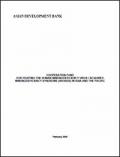Publications - Released in 2005
In Asia and the Pacific at the end of 2004, the Joint United Nations Programme on HIV/AIDS (UNAIDS) estimates that 8.2 million people were living with HIV and the associated disease condition of AIDS, including 2.3 million women. This increased from 7.2 million in 2002 (women, 1.9 million). UNAIDS estimates that in 2004, 1.2 million people in the region became infected with HIV and 540,000 adults and children died from AIDS. The rapid increase of infections among women is particularly marked. In Cambodia, Myanmar, Papua New Guinea, Thailand, and several states of India the epidemic is firmly established in the general population. In other countries (e.g., People's Republic of China, Indonesia, and Viet Nam), low overall population prevalence rates disguise high, and rapidly growing, infection rates in specific population groups.
In 2002, Dr. Peter Piot, the Executive Director of UNAIDS, stated: "The epidemic in Asia threatens to become the largest in the world. With more than half the world's population, the region must treat AIDS as an issue of regional urgency. The question is no longer whether Asia and the Pacific will have a major epidemic, but rather how massive it will be." The goal for the Asian Development Bank (ADB) is to be an effective partner to its developing member countries (DMCs) in addressing this challenge.
Downloads
Organizations
- Asian Development Bank (ADB)






